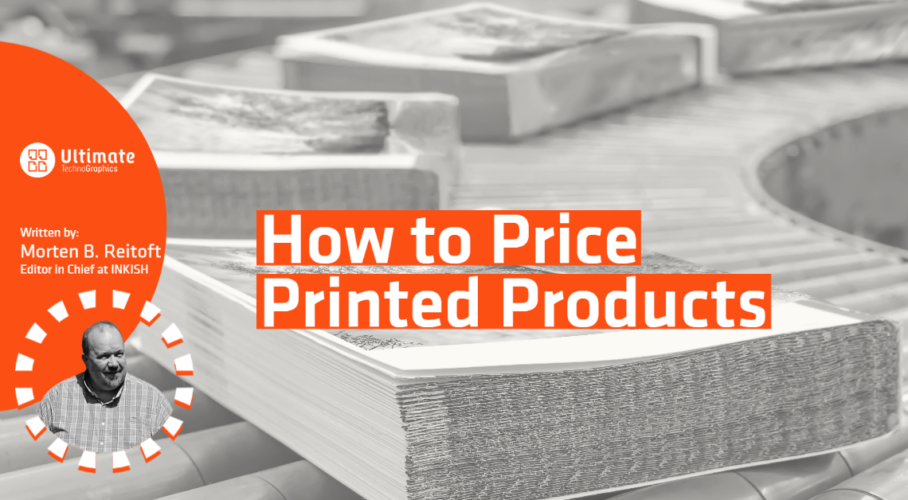Friends and followers, this is Morten B. Reitoft from INKISH, and in this Ultimate TechnoGraphics blog, I have the pleasure of writing about one of my favorite topics – pricing, but first, a disclaimer. No single strategy works, so I will try to argue in favor of value-added pricing vs. the more commonly full-cost model in this article. But regardless of the model, the idea is to make you as profitable as possible 🙂
So how are most printing companies and production companies working today?
Most printing companies use what’s called a full-cost model. With this model, you calculate the cost of your production based on several parameters such as utilization (as an hourly rate), direct labor cost, and variables like ink, blankets, plates, etc. If your base parameters are set correctly, you will get a pretty accurate production price – but there are a couple of issues. First, a critical parameter when you look at full-cost models is how much a machine is used. Suppose you have pre-calculated your hourly rate based on 70% utilization. In that case, you know as well as me that some weeks it won’t be the case. Therefore, the “ideal” would be to change the calculated utilization dynamically – but that will lead to other and more complex problems – like different prices every time you calculate! If you end up with an average utilization percentage, the costing model will always be entirely wrong – unless you hit that average.
The other and more important thing…
The other and more important thing is that cost has nothing to do with sales prices, and a good example you can check for yourself. If you look at all your customers, I am convinced you often sell the same types of products, i.e., Business Cards, Flyers, Posters, or something else, to many different customers. Do all your customers buy at the same price? Most likely not, unless you operate as an online printer with fixed prices or based on a pricelist!
When I used to work in a printing company, our prices on various products were based on many different parameters and always individually priced to ‘maximize the profit.’ So we know this as expected.
We also know from all the products we buy in shops that sometimes the same product is sold at different prices – so it’s easy to understand that prices vary – ergo – the sales prices can’t be based on cost – or not cost alone!
With different prices, you can argue that prices are based on value rather than cost. The value you add is based on the services you offer, your brand and reliability, the relationships you have with your customer, and with a lot of parameters that would be difficult to add to any costing model.
So when I argue for value-added pricing models, it starts with a simple question – what value do you add to a product? Is it only the paper, the ink, and the machine time, or does it also have something to do with the process, the people involved, and everything mentioned above?
When you buy online – you are often asked if you want additional services – like expedited delivery, file check, better paper quality, etc.
Every time you tick the box, it adds to the cost, making it highly transparent that your additional service comes at a price. Unfortunately, many conventional printing companies are pretty bad at pricing the service and end up being compared with an online printing company, where all the services have been removed.
So what can you do relatively quickly to understand value-added pricing?
When you give an offer, describe what you offer in detail. When you invoice, be sure to add ALL the services you have added to the order. You identify the services the customer assumed were part of working with you, and you may need to credit these additional services later to align with your offer.
But now you have declared the REAL value of your product and service, and colleagues, customers, management, and your financial people will understand what you have delivered.
I learned this from an old guy that I worked with, who, into the almost insane details, described the work he did. A simple invoice could easily be several pages long.
The next step in value-added pricing is also quite interesting.
When you use full-cost models, you typically calculate a full production and include everything from waste to shipping into account. Essentially, you waste a lot of time, as only a percentage of your offers are converted into orders. What often happened when I was managing a sales department was a general misbelief from the salespeople. They didn’t trust the prices from the MIS system and often sold projects with discounts without even knowing whether the price was too high!
The issue was – and I believe still is – that computers and MIS systems rarely understand sales psychology. So I added a tiny feature to our MIS system, requiring the salesperson to guess the price of the product quoted before he could see the price from the MIS system.
In the beginning…
In the beginning, salespeople and project managers guessed prices way higher than the calculated price. After some time, the prices increasingly aligned, and the side effect was higher profits. The added value in the example above comes from changing nothing but using psychology to motivate change!
Value-Added pricing is, however, way more than this. You must understand what the customer wants and then deliver what he wants at the price he is willing to pay. No computer systems in the world can help you with that.
If you want to understand more about my ideas, I spoke at a webinar for Ultimate TechnoGraphics, which you can see by following this link!

